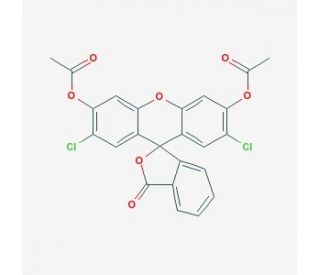

2′,7′-Dichlorofluorescein diacetate (CAS 2044-85-1)
See product citations (19)
QUICK LINKS
2′,7′-Dichlorofluorescein diacetate is a chemical compound with various applications in scientific research and laboratory applications. It is derived from fluorescein, a well-known fluorescent dye used for visualization and detection purposes. 2′,7′-Dichlorofluorescein diacetate, also known as DCFH-DA, possesses unique properties that make it valuable in experimental studies. It is a cell-permeable compound that can freely enter living cells due to its acetylated form. Once inside the cells, cellular esterases hydrolyze the diacetate groups, releasing the non-fluorescent DCFH (2′,7′-Dichlorofluorescein) compound. DCFH can be further oxidized by reactive oxygen species (ROS) present in the cell′s environment, resulting in the formation of the highly fluorescent compound 2′,7′-Dichlorofluorescein (DCF). This fluorescence can be quantified and monitored using various techniques, such as fluorescence microscopy, flow cytometry, or spectrofluorometry. The unique property of DCFH-DA to detect and measure intracellular ROS levels has made it an invaluable tool in studying oxidative stress, redox signaling, and cellular antioxidant responses. By visualizing and quantifying ROS production, researchers can gain insights into the role of oxidative stress in various physiological and pathological processes. Additionally, DCFH-DA has been utilized in various applications, including assessing cell viability and studying cellular oxidative damage. Its versatility extends to different research areas, such as cell biology, immunology, neurobiology, and environmental sciences.
2′,7′-Dichlorofluorescein diacetate (CAS 2044-85-1) References
- Are synapses targets of nanoparticles? | Fedorovich, SV., et al. 2010. Biochem Soc Trans. 38: 536-8. PMID: 20298217
- Characterization of primary cultures of cholesteatoma-associated fibroblasts. | Barbara, M., et al. 2012. Otol Neurotol. 33: 988-95. PMID: 22772001
- MicroRNAs and reactive oxygen species: are they in the same regulatory circuit? | Jaksik, R., et al. 2014. Mutat Res Genet Toxicol Environ Mutagen. 764-765: 64-71. PMID: 24051449
- Hypoxia enhances antitumor activity of dichloroacetate. | Kolesnik, DL., et al. 2014. Exp Oncol. 36: 231-5. PMID: 25537215
- Free p-Cresol Alters Neutrophil Function in Dogs. | Bosco, AM., et al. 2016. Artif Organs. 40: 480-8. PMID: 26496142
- Iron overloaded polarizes macrophage to proinflammation phenotype through ROS/acetyl-p53 pathway. | Zhou, Y., et al. 2018. Cancer Med. 7: 4012-4022. PMID: 29989329
- Andrographis paniculata and Its Bioactive Diterpenoids Against Inflammation and Oxidative Stress in Keratinocytes. | Mussard, E., et al. 2020. Antioxidants (Basel). 9: PMID: 32560449
- 4-Hydroxyhalcone effects on cisplatin-induced genotoxicity model. | Nazari, A., et al. 2021. Toxicol Res (Camb). 10: 11-17. PMID: 33613968
- N-Acetyl cysteine improves cellular growth in respiratory-deficient yeast. | Chapela, SP., et al. 2022. Braz J Microbiol. 53: 791-794. PMID: 35122656
- In-vitro toxicity assessment of Eucalyptus robusta Smith extracts via whole-cell bioreporter. | Jin, N., et al. 2022. Ecotoxicol Environ Saf. 240: 113704. PMID: 35653968
- Visible-Light-Driven Antimicrobial Activity and Mechanism of Polydopamine-Reduced Graphene Oxide/BiVO4 Composite. | Li, B., et al. 2022. Int J Mol Sci. 23: PMID: 35887058
- Puerarin prevents calcium oxalate crystal-induced renal epithelial cell autophagy by activating the SIRT1-mediated signaling pathway. | Jing, GH., et al. 2022. Urolithiasis. 50: 545-556. PMID: 35913552
- Pinoresinol diglucoside ameliorates H/R-induced injury of cardiomyocytes by regulating miR-142-3p and HIF1AN. | Wei, Y., et al. 2022. J Biochem Mol Toxicol. 36: e23175. PMID: 35962614
- A microplate-based DCFH-DA assay for the evaluation of oxidative stress in whole semen. | Benedetti, S., et al. 2022. Heliyon. 8: e10642. PMID: 36158085
- In vivo effects of chromium. | Witmer, C., et al. 1994. Environ Health Perspect. 102 Suppl 3: 169-76. PMID: 7843092
Ordering Information
| Product Name | Catalog # | UNIT | Price | Qty | FAVORITES | |
2′,7′-Dichlorofluorescein diacetate, 1 g | sc-209391 | 1 g | $138.00 | |||
2′,7′-Dichlorofluorescein diacetate, 5 g | sc-209391A | 5 g | $559.00 |
